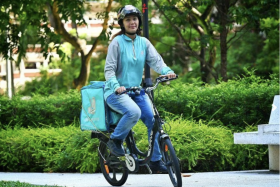She was inspired by Darwin, Attenborough
From an ancient mummy to prehistoric beasts, Miss Susan Holmes has seen it all
Growing up, Miss Susan Holmes, 38, would scour southern England's coasts for fossils while other children her age played sports and video games.
One of her chief inspirations was Charles Darwin.
Decades on, she is helping to present an extract from Darwin's seminal work, On The Origin Of Species, for the ArtScience Museum's Treasures of the Natural World exhibition, on till April 29.
"It felt surreal looking at Darwin's manuscript. It revolutionised the study of nature, and he stood by his theory despite the religious backlash," Miss Holmes told The New Paper over the phone from the UK recently.
As exhibition and interpretation manager at London's Natural History Museum, she introduces specimens to the public by explaining their historical and scientific backstories in international exhibitions.
The exhibition at ArtScience Museum is one of the largest ever staged by the Natural History Museum, and it will feature more than 200 objects, including a Martian meteorite and insect specimens collected by British naturalist Alfred Russel Wallace from his travels to the Malay archipelago.
Miss Holmes has variously been inspired by figures such as Sir David Attenborough and explorers both real and fake, like James Cook and Indiana Jones.
The story of self-educated English fossil hunter Mary Anning, who was a poverty-stricken girl when she discovered the first plesiosaur bones in 1821, also gave Miss Holmes dreams of being a paleontologist, a scientist who studies dinosaurs.
After a childhood of museum trips with her parents, she did graphic design and fine arts for her A levels before obtaining her Master of Arts degree in Museum Studies in 2003.
"Being an interpreter means that I am not restricted to specific fields like just archaeology or palaeontology. As a generalist, I collaborate with experts across every scientific discipline - so there is something exciting to discover every day," she said.
During a previous stint at The British Museum, she worked on specimens such as the Gebelein Man, a 5,500-year-old mummy.
"I helped create the mummy's virtual autopsy for the public to learn more about him," she said. "Mummified naturally by Egypt's heat and sand, he is of the best-preserved mummies in the world."
She still bears a scar from catching her arm on a sieve used in an excavation at Sha'ar HaGolan, Israel, back in 2002. Discovered in the 1940s, the site was an 8,000-year-old Neolithic village that had mudbrick buildings and sported "the earliest examples of roads".
Equally fascinated by dinosaurs, she said: "I was once in Spain's La Rioja region to conserve footprints made by Sauropod dinosaurs that roamed around 120 million years ago in Europe. This meant preventing plant growth, filling in cracks and making the site presentable to the public."
Since joining the Natural History Museum in 2014, she has been handling more biological and taxidermied specimens.
One such specimen chosen for the ArtScience exhibition is a sabre-toothed cat's skeleton.
"The cat sported fangs long enough to puncture the jugular arteries of (elephant-size) mammoths and coexisted with humans. Thankfully, it went extinct around 12,000 years ago - I certainly wouldn't want to be ambushed by one."
She added: "My work has shown me that life is fragile. By protecting the natural world's biodiversity, we can find solutions to problems such as diseases, food insecurity and how to sustain mankind in future."
Get The New Paper on your phone with the free TNP app. Download from the Apple App Store or Google Play Store now



